Earlier this month, I wrote a “rant” in 2¢ Worth that garnered a good deal of response. The post, Teachers & Technology – a Rant!, came mostly from a blog article written here, by a Technology & Learning Blogger, but also from some of its comments and other posts that I had read that day. It was a bit of a stress releasing vent. It’s why I called it a rant. And it’s part of what’s difficult about blogging, that you(I) see each article as a continuation, just one point along a spectrum of our knowledge, attitudes, beliefs, aspirations, and emotional condition.
However, when people read your blog article, they are typically seeing only that one point, looking through that single break in the fence, and, therefore, reacting to only a small part of my story — and this is not necessarily a bad thing. When you teach history, it is usually one decade, or one influence, or one event at a time. If done right, then the result is a broad and useful perspective.
Yesterday, while scanning through my aggregator, I ran across two more references to that article. Chris Lehmann (Practical Theory) wrote Don’t Blame the Victim…, which I’d actually read before but hadn’t had time to respond. In that post, Chris Wrote:
There’s a lot of writing going on about how teachers don’t have the right to be technologically illiterate today, that they can’t, won’t shaltn’t… And, and I don’t mean to be picking on David or Karl, two voices I deeply, deeply respect, there seems to be a sense that, if it weren’t for those darned teachers who won’t learn, we’d have the schools we need.
That little blurb is highly misrepresentative of Chris’ entire article, so I strongly recommend that you link over and read the whole thing. After reading it, I commented with…
Thanks for this post. It is, perhaps, the best thing about blogging, that the greatest value comes out of the conversation, the sharing and growing of perspective. ..that a simple rant can expand into a much larger, more accurate, and useful examination of a topic.
In my state, we are facing a potentially catastrophic shortage of teachers. The are leaving the profession faster than we can replace them, and I do not believe that it is (just) the pay. It’s that teachers pursue this job because they have a healthy notion of what it is to succeed with students. They know, because they’ve experienced those moments as students, when a teacher succeeded in helping them to grow, to be more than they were before.
But then they enter an institution that seems set up for failure. Barriers at almost every point prevent that success — barriers of policy, barriers of expectations, barriers of time, support, resources, and barriers of shear political cowardice.
I happen to think that there is only a very thin line between a mediocre teacher and a great teacher, but it takes some pretty large steps from the entire institution to cross that line.
Jamie, a school librarian in Houston, wrote an entry in Books and Bytes, a piece called Teachers as Learners. Again, I highly recommend that you click over and read the entire post. But the small part of it that I am responding to reads…
More than a few times, teachers have stated to me that professional development & technology training should be on school time, not personal time. The overriding perception is that “in the “real” (business) world, people are paid to be trained, but the poor teachers have to do it all on their own time. By and large this is not true, from my observation of friends and family members not in education!
I commented…
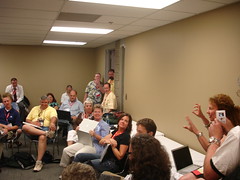 Thanks for this post, Jamie, and for linking to my blog. I think that you make a valid and useful point, that other professionals do engage in professional development on their own time, and they often take work home with them, etc.
Thanks for this post, Jamie, and for linking to my blog. I think that you make a valid and useful point, that other professionals do engage in professional development on their own time, and they often take work home with them, etc.
But I would also side with your teachers in that one of the problems with teaching, and one of the barriers to education reform, is the notion that what teachers do is teach. That the job is to work with students to help them learn — and that is all.
We both know that there is so much more to being an educator than teaching — especially in a time of rapid change and a dramatically shifting information landscape. It requires research, collaboration, material and strategy development, professional development, information management, planning, teacher field trips, and professional reflection.
I think that we need to figure out a way to re-image teaching, for the community. We need to project it as a dynamic profession that is more than just teaching the same old thing. It’s about crafting learning experiences for students that introduce them to the world that they will inherit.
This is obviously a complex issue, as education should be. Its more than can be expressed in a single blog. The job is not simple — not any more. The world that we are preparing our children for is complex, dynamic, and it may never be the same again. But it is also intensely exciting — a fact that I only discovered after graduating from school. ..and learning about that world, should be just as exciting as that world really is.

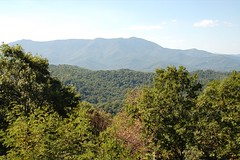

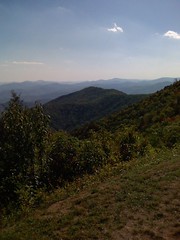
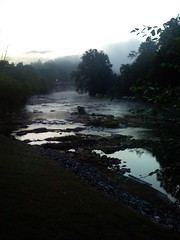


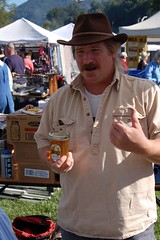

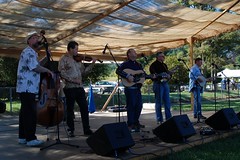
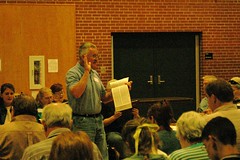
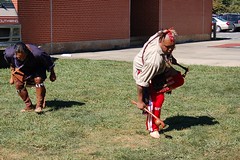

 With the
With the  Barry Bachenheimer posted a comment on one of my articles the other day that I thought I would just drop-cast out to other blogging educators — for your spare change. It’s a good question, one that bigger bloggers than us ponder. “Does a blog in the woods, that no one reads, make any noise?”
Barry Bachenheimer posted a comment on one of my articles the other day that I thought I would just drop-cast out to other blogging educators — for your spare change. It’s a good question, one that bigger bloggers than us ponder. “Does a blog in the woods, that no one reads, make any noise?”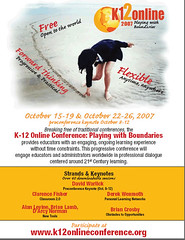
 Several years ago, I had a conversation with a tech director for a school district in Arkansas. I do not remember who it was, or what school district — but I was impress by the fact that the district was providing e-mail accounts on their own server, unfiltered. This was a time before blogs and Wikipedia, and I didn’t know of any districts that were allowing students to use e-mail, except for a handful of
Several years ago, I had a conversation with a tech director for a school district in Arkansas. I do not remember who it was, or what school district — but I was impress by the fact that the district was providing e-mail accounts on their own server, unfiltered. This was a time before blogs and Wikipedia, and I didn’t know of any districts that were allowing students to use e-mail, except for a handful of  Thanks for this post, Jamie, and for linking to my blog. I think that you make a valid and useful point, that other professionals do engage in professional development on their own time, and they often take work home with them, etc.
Thanks for this post, Jamie, and for linking to my blog. I think that you make a valid and useful point, that other professionals do engage in professional development on their own time, and they often take work home with them, etc. On the spur, just before scanning through e-mail, I took a glance at Twitter, seeing, not surprisingly, a recent post from Jeff Utecht — well into Sunday there in Shanghai. He said
On the spur, just before scanning through e-mail, I took a glance at Twitter, seeing, not surprisingly, a recent post from Jeff Utecht — well into Sunday there in Shanghai. He said
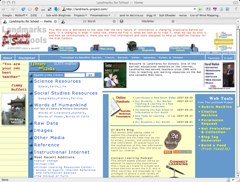 On Thursday, while working at the coffee shop, I received a call on my mobile from a woman who was speaking in a fairly thick accent — rather difficult for me to understand. I walked outside, out of the sounds of Starbucks, leaned against the window so that I could keep an eye on my laptop, and listened.
On Thursday, while working at the coffee shop, I received a call on my mobile from a woman who was speaking in a fairly thick accent — rather difficult for me to understand. I walked outside, out of the sounds of Starbucks, leaned against the window so that I could keep an eye on my laptop, and listened.